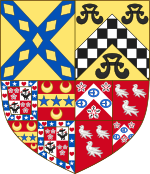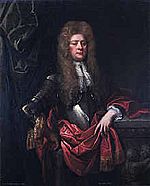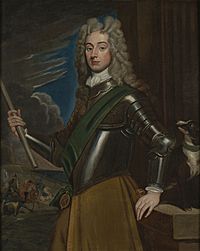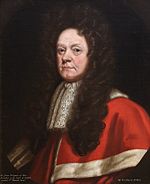Earl of Stair facts for kids
Quick facts for kids Earldom of Stair |
|
|---|---|
 
Blazon
Arms: Quarterly: 1st grandquarter, Or on a Saltire Azure nine Lozenges of the field (Dalrymple); 2nd grandquarter, Or a Chevron chequy Sable and Argent between three Water Bougets of the second (Ross); 3rd grandquarter, quarterly: 1st and 4th counterquartered: 1st and 4th, Gules three Cinquefoils Ermine; 2nd and 3rd, Argent a Galley sales furled Sable; the whole within a Bordure company Argent and Azure, the first charged with Hearts Gules and the second with Mullets Argent (Hamilton of Bargany); 2nd and 3rd, Gules on a Fess between three Crescents Or as many Mullets Azure (de Franquetot); 4th grandquarter, quarterly: 1st and 4th, Gules on a Chevron between three Cinquefoils Argent as many Round Buckles Azure (Hamilton of Fala); 2nd and 3rd, Gules three Martlets Argent (Makgill)
Crest:A Rock proper Supporters: On either side a Stork holding in its beak a Fish all proper |
|
| Creation date | 8 April 1703 |
| Monarch | Anne, Queen of Great Britain |
| Peerage | Peerage of Scotland |
| First holder | John Dalrymple, 1st Earl of Stair |
| Present holder | John James David Dalrymple, 14th Earl of Stair |
| Heir presumptive | John James Thomas Dalrymple, Viscount Dalrymple |
| Subsidiary titles | Viscount of Stair Viscount Dalrymple Baron Oxenfoord of Cousland Lord Newliston, Glenluce and Stranraer Lord Glenluce and Stranraer Baronet Dalrymple of Stair Baronet Dalrymple of Cranstoun |
| Status | Extant |
| Seat(s) | Lochinch Castle Oxenfoord Castle |
| Motto | FIRM |

The Earl of Stair is a special title in the Peerage of Scotland. A "peerage" is a system of titles for important families, like Duke, Marquess, Earl, Viscount, and Baron. This title was first given in 1703 to a smart lawyer and politician named John Dalrymple. He was already the 2nd Viscount of Stair.
John Dalrymple's father, James Dalrymple, was also a very important lawyer. He was the main judge in Scotland's highest court, called the Lord President of the Court of Session. For his work, he was made a "baronet" in 1664. A baronet is a hereditary title, like a knight, but it can be passed down in the family. Later, in 1690, he received the titles of Lord Glenluce and Stranraer and Viscount of Stair. These were also Scottish peerage titles.

Contents
The First Earl of Stair
John Dalrymple, the first Earl, strongly supported King William III. He worked as the Secretary of State for Scotland, which meant he was a top government official. However, he had to leave his job after a sad event in 1692. When he became an Earl, he also received two other titles: Lord Newliston, Glenluce and Stranraer and Viscount of Dalrymple. These titles were set up so that if he didn't have any sons, they could be passed down to his father's male relatives.
How the Title Was Passed Down
The first Earl's oldest son became the second Earl. He was a famous soldier and led the army as Commander-in-Chief of the Forces. In 1707, he gave up his titles to the King. He then got a new agreement that let him choose any male descendant of the first Viscount of Stair to be his successor.
In 1747, the second Earl chose his nephew, John Dalrymple, to take over the title. This was because his second brother, William Dalrymple, had married a Countess, and their children would inherit her titles instead. However, this choice was challenged. The House of Lords, which is part of the UK Parliament, decided that the Earl couldn't choose his successor after the Treaty of Union in 1707. So, his nephew James Dalrymple became the third Earl of Stair instead.
The third Earl had no children. His older brother became the fourth Earl. This brother was also the fifth Earl of Dumfries through his mother. When he died in 1768, the two Earldoms separated. The Earldom of Stair went to his cousin, John Dalrymple, who became the fifth Earl. This was the same John Dalrymple whom the second Earl had originally wanted to be his successor.
The fifth Earl's son became the sixth Earl. He was a Scottish Representative Peer in the House of Lords for many years. This meant he represented Scotland's nobility in Parliament. He also served as an Ambassador to Prussia, which is now part of Germany.
Later Earls
The sixth Earl died without children. His cousin became the seventh Earl. He also had no children. So, the title went to a more distant relative, Sir John Hamilton Dalrymple, who was the 5th Baronet of Killock. He became the eighth Earl of Stair.
The eighth Earl was a General in the Army. He was also a Member of Parliament for Edinburgh, meaning he was elected to represent the city in the House of Commons. In 1841, he received a new title, Baron Oxenfoord, in the Peerage of the United Kingdom. This new title meant that the Earls of Stair would automatically have a seat in the House of Lords. The Oxenfoord title was named after his home, Oxenfoord Castle.
His younger brother became the ninth Earl. His son, the tenth Earl, was also a Conservative Member of Parliament and a Lord Lieutenant for two areas in Scotland. A Lord Lieutenant is the King's representative in a county. His grandson, the twelfth Earl, also served as a Member of Parliament and Lord Lieutenant.
The current Earl is John James David Dalrymple, the fourteenth Earl. He became Earl in 1996. In 2008, he was chosen to be a "Hereditary Cross-Bench Peer" in the House of Lords. This means he inherited his seat and doesn't belong to a specific political party.
Dalrymple Baronets
The Dalrymple Baronetcy of Killock was created in 1698 for James Dalrymple. He was the second son of the first Viscount of Stair. His great-grandson, the fourth Baronet, was a judge in Scotland. He married his cousin, Elizabeth Macgill, who was related to the Viscounts of Oxfuird. Their son, the fifth Baronet, later became the eighth Earl of Stair in 1840.
Another important Dalrymple family member was Hew Dalrymple. He was the third son of the first Viscount of Stair. He also served as the main judge in Scotland, like his father. In 1697, he was made a baronet, of North Berwick. You can find more information about other Dalrymple family branches in the Dalrymple baronets article.
Family Homes
The title "Earl of Stair" comes from a small village called Stair. This was the original home of the Dalrymple family, who settled there way back in the 1100s. To help create the original title, James Dalrymple, 1st Viscount Stair, even had a part of a nearby area separated to form the Parish of Stair in 1653.
Today, the family's main homes are Lochinch Castle near Stranraer and Oxenfoord Castle near Pathhead.
Viscounts of Stair (1690)
- James Dalrymple, 1st Viscount of Stair (1619–1695)
- John Dalrymple, 2nd Viscount of Stair (became the 1st Earl of Stair in 1703)
Earls of Stair (1703)
- John Dalrymple, 1st Earl of Stair (1648–1707)
- John Dalrymple, 2nd Earl of Stair (1673–1747)
- James Dalrymple, 3rd Earl of Stair (died 1760)
- William Dalrymple-Crichton, 5th Earl of Dumfries and 4th Earl of Stair (1699–1769)
- John Dalrymple, 5th Earl of Stair (1720–1789)
- John Dalrymple, 6th Earl of Stair (1749–1821)
- John William Henry Dalrymple, 7th Earl of Stair (1784–1840)
- John Hamilton Dalrymple, 8th Earl of Stair (1771–1853)
- North Hamilton Dalrymple, 9th Earl of Stair (1776–1864)
- John Hamilton Dalrymple, 10th Earl of Stair (1819–1903)
- John Hew North Gustav Henry Hamilton-Dalrymple, 11th Earl of Stair (1848–1914)
- John James Dalrymple, 12th Earl of Stair (1879–1961)
- John Aymer Dalrymple, 13th Earl of Stair (1906–1996)
- John David James Dalrymple, 14th Earl of Stair (born 1961)
The heir apparent (the person next in line to inherit the title) is the current Earl's son, John James Thomas Dalrymple, who is known as Viscount Dalrymple. He was born in 2008.
See also
- Dalrymple baronets
- Earl of Dumfries
- Hamilton-Dalrymple baronets
- Admiral Sir Frederick Dalrymple-Hamilton


